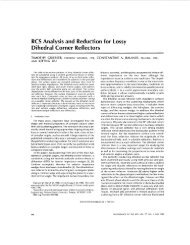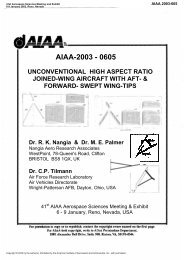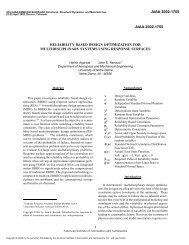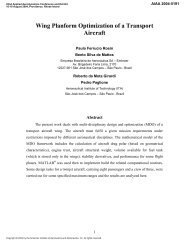Application of MDO to Large Subsonic Transport Aircraft
Application of MDO to Large Subsonic Transport Aircraft
Application of MDO to Large Subsonic Transport Aircraft
Create successful ePaper yourself
Turn your PDF publications into a flip-book with our unique Google optimized e-Paper software.
(c)2000 American Institute <strong>of</strong> Aeronautics & Astronautics or published with permission <strong>of</strong> author(s) and/or author(s)’ sponsoring organization.<br />
Fig.9 Optimized configuration at cruise as analyzed with the Flower NS code<br />
Conclusion<br />
We have presented a new wing preliminary<br />
design method that:<br />
a’, allows for estimation <strong>of</strong> transonic<br />
aerodynamic performance even in the early<br />
sizing procedure<br />
b) accounts for the aeroelastic deformations <strong>of</strong><br />
the wing in cruise and in load defining cases<br />
c) enables significant performance improvements<br />
by interdisciplinary balancing the<br />
most significant design parameters.<br />
This was only possible by extracting the<br />
significant physical properties and casting them<br />
in<strong>to</strong> new, dedicated models for the preliminary<br />
design process. These models were calibrated<br />
using higher accuracy data from other sources.<br />
Furthermore, the most significant design<br />
parameters were identified and included in the<br />
10<br />
American Institute for Aeronautics and Astronautics<br />
optimizer’s variations. Future applications in the<br />
aircraft development have <strong>to</strong> include realistic<br />
constraints, such as landing gear housing,<br />
planform limitations by ground procedures, etc.<br />
Additionally, a more accurate cost function<br />
should be developed which represents the<br />
essential project targets <strong>of</strong> the manufacturer.<br />
Today, optimization within the individual<br />
disciplines is mature, but allows only for small<br />
improvements. On <strong>to</strong>p <strong>of</strong> that, an improvement<br />
in one discipline can cause a penalty in another<br />
discipline.<br />
In this paper, we presented a method whereby the<br />
minimum design modification was identified that<br />
produced the maximum <strong>to</strong>tal benefit for the<br />
design. These design modifications consisted out<br />
<strong>of</strong> the simultaneous modification <strong>of</strong> multiple<br />
design parameters. We showed that this result<br />
was not and (likely) cannot be achieved by<br />
conventional trade studies.








![Introduction to RF Stealth [Book Review] - Antennas and ...](https://img.yumpu.com/16857890/1/190x245/introduction-to-rf-stealth-book-review-antennas-and-.jpg?quality=85)







